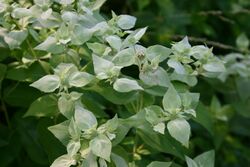Biology:Pycnanthemum
| Mountain mints | |
|---|---|

| |
| Short-toothed mountain mint (Pycnanthemum muticum) | |
| Scientific classification | |
| Kingdom: | Plantae |
| Clade: | Tracheophytes |
| Clade: | Angiosperms |
| Clade: | Eudicots |
| Clade: | Asterids |
| Order: | Lamiales |
| Family: | Lamiaceae |
| Subfamily: | Nepetoideae |
| Tribe: | Mentheae |
| Genus: | Pycnanthemum Michx. |
| Synonyms[1] | |
| |
Pycnanthemum is a genus of herbaceous plants in the mint family (Lamiaceae). Species in this genus are often referred to as "mountain mints" and they often have a minty or thyme-like aroma when crushed. All species of Pycnanthemum are native to the United States and Canada .[1][2][3] The center of diversity for the genus is North Carolina with 13 of the 20 species having been collected therein. Nineteen of the 20 species of Pycnanthemum occur in the Eastern US and Canada, and one disjunct species (P. californicum) occurs in California and Oregon.
Pycnanthemum is derived from Greek. The Greek word "pyknos" has the meaning of "dense", "tight", or "close-packed".[4][5] It was combined with "anthos" meaning flower to give the genus name.[6]
Pycnanthemum belongs to the true mint subtribe (Menthinae),[7] and it has been shown to be closely related to the Monarda, Blephilia, and the scrub mints of the Southeastern United States.[8] Relationships within the genus remain unresolved. A complicated history of polyploidization paired with cryptic morphologies makes this a challenging group for systematists.[9]
Species
- Pycnanthemum albescens Torr. & A.Gray – white-leaved mountainmint – south-central US
- Pycnanthemum beadlei (Small) Fernald – North Carolina, South Carolina, Virginia, eastern Tennessee, northern Georgia
- Pycnanthemum californicum Torr. ex Durand – Sierra mint – California
- Pycnanthemum clinopodioides Torr. & A.Gray – mid-Atlantic States, Tennessee, Indiana
- Pycnanthemum curvipes (Greene) E.Grant & Epling – southeastern US
- Pycnanthemum flexuosum (Walter) Britton, Sterns & Poggenb. – southeastern US
- Pycnanthemum floridanum E.Grant & Epling – Florida mountainmint – Florida, southern Georgia
- Pycnanthemum incanum (L.) Michx. – hoary mountainmint, hoary basil, wild basil – Ontario, most of US east of the Mississippi River
- Pycnanthemum loomisii Nutt. – Loomis' mountainmint – southeastern US, Ohio Valley
- †Pycnanthemum monotrichum Fernald – Virginia but extinct
- Pycnanthemum montanum Michx. – southern Appalachians
- Pycnanthemum muticum (Michx.) Pers. – short-toothed mountainmint – much of eastern US from east Texas to southern Maine
- Pycnanthemum nudum Nutt. – Coastal Plain mountainmint – southeastern US
- Pycnanthemum pilosum Nutt. ( = P. verticillatum var. pilosum) – hairy mountainmint, whorled mountainmint
- Pycnanthemum pycnanthemoides (Leavenw.) Fernald – southern mountainmint – southeastern US, Ohio Valley
- Pycnanthemum setosum Nutt. – awned mountainmint – southeastern + mid-Atlantic US
- Pycnanthemum tenuifolium Schrad. – little-leaved mountainmint, slender-leaved mountainmint (= P. flexuosum auct. non Walter) – Quebec, Ontario, eastern + central US
- Pycnanthemum torreyi Benth. – Torrey's mountainmint – eastern + east-central US
- Pycnanthemum verticillatum (Michx.) Pers. – whorled mountainmint – Quebec, Ontario, eastern + central US
- Pycnanthemum virginianum (L.) T.Durand & B.D.Jacks. ex B.L.Rob. – Virginia mountainmint – Quebec, Ontario, eastern + central US
Pycnanthemum tenuifolium with ripening seed
Footnotes
- ↑ 1.0 1.1 "Pycnanthemum". World Checklist of Selected Plant Families (WCSP). Royal Botanic Gardens, Kew. http://wcsp.science.kew.org/namedetail.do?name_id=171031.
- ↑ "Pycnanthemum", County-level distribution maps from the North American Plant Atlas (NAPA) (Biota of North America Program (BONAP)), 2013, http://bonap.net/NAPA/TaxonMaps/Genus/County/Pycnanthemum
- ↑ Chambers, Henrietta L. (1961-01-01). "Chromosome numbers and breeding systems in Pycnanthemum (Labiatae)" (in en). Brittonia 13 (1): 116–128. doi:10.2307/2805290. ISSN 1938-436X. https://doi.org/10.2307/2805290.
- ↑ Henderson, I.F.; Henderson, W.D.; Kenneth, J.H. (1939). A Dictionary of Scientific Terms (3rd ed.). Edinburgh, United Kingdom: Oliver and Boyd. p. 292. https://archive.org/details/in.ernet.dli.2015.205149/page/n310. Retrieved 26 January 2024.
- ↑ Ingram, David S. (1999). Plant Disease : A Natural History. London: HarperCollins. p. 262. ISBN 978-0-00-220074-5. https://archive.org/details/plantdiseasenatu0000ingr/page/262. Retrieved 26 January 2024.
- ↑ "Pycnanthemum virginianum" (in en). Missouri Botanical Garden. https://www.missouribotanicalgarden.org/PlantFinder/PlantFinderDetails.aspx?kempercode=l880.
- ↑ Ryding, Olof (2009-06-01). "Pericarp structure in Monarda (Lamiaceae)". Botanische Jahrbücher für Systematik, Pflanzengeschichte und Pflanzengeographie 127 (4): 453–458. doi:10.1127/0006-8152/2009/0127-0453. ISSN 0006-8152. http://dx.doi.org/10.1127/0006-8152/2009/0127-0453.
- ↑ Edwards, Christine E.; Soltis, Douglas E.; Soltis, Pamela S. (2006-01-01). "Molecular Phylogeny of Conradina and Other Scrub Mints (Lamiaceae) from the Southeastern USA: Evidence for Hybridization in Pleistocene Refugia?". Systematic Botany 31 (1): 193–207. doi:10.1600/036364406775971688. ISSN 0363-6445. http://dx.doi.org/10.1600/036364406775971688.
- ↑ Chambers, Henrietta L.; Chambers, Kenton L. (January 1971). "Artificial and Natural Hybrids in Pycnanthemum (Labiatae)". Brittonia 23 (1): 71. doi:10.2307/2805843. ISSN 0007-196X. http://dx.doi.org/10.2307/2805843.
References
- United States Department of Agriculture (USDA) (2007): Germplasm Resources Information Network – Pycnanthemum. Version of 2007-OCT-05. Retrieved 2011-FEB-18.
External links
- Barbara Pleasant. The Herb Companion: Herb-To-Know: Mountain Mint.
- Jeffrey S. Pippen Duke University. North Carolina Wildflowers, Shrubs, & Trees: Pycnanthemum.
- Henriette's Herbal Homepage: Pycnanthemum.
Wikidata ☰ Q2707696 entry
 |







